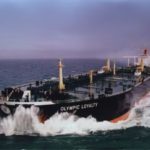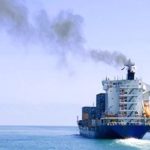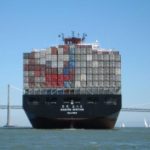Hellenic Shipping News interviews Mr. A.Prokopakis, Head of Shipping Operations of Mamidakis Group.
Shipping emissions, freight rates and the business strategy implemented by Mamidakis Group, home to Styga Maritime and Jetoil Bunkering were some of the issues discussed with Mr. Alexandros Prokopakis, in charge of all shipping-
related aspects of one of Hellas’ leading oil trading and shipping groups.
Let’s start with providing us with a brief profile of shipping operation of Mamidakis Group, mainly expressed through Styga Maritime and Jetoil Bunkering.
As you said, Styga Maritime is the maritime company of the Group, which has over 35 years of experience in the business. Today, the company owns and operates four tankers, since the wet sector has traditionally been our field, although during the years we’ve also dealt with OBO’s and bulk carriers. Three years ago we decided to renew our fleet, which at the time consisted of older single-bottom vessels with an average age of 17 years. Our new tankers have an average age of 9 years old and of course all of them are double-hulled. One of them is a product carrier of 47,000-dwt, another is in the panamax category with a capacity of 70,000-dwt and the remaining two are smaller product tankers of 14,000-dwt. One of them actually is undergoing a conversion into double-hull design in Turkey and we are about to time-charter it. The two larger vessels are also under time-charters with a first-class charterer. The last vessel is trading in the spot market.
Besides Styga Maritime, we are also running Jetank, a subsidiary of Jetoil, which operates seven feeders. Four of them are responsible for delivering oil in our main operations in Piraeus, while the remaining three are used to supply oil to the Greek islands, or even to close destinations abroad, like the Balkans or even the Black Sea. These vessels have a capacity of between 1,000 and 4,000-dwt.
Besides them of course, there is Jetoil Bunkering which is operating the bunkering business, isn’t it?
Yes, Jetoil Bunkering, also under the umbrella of Jetoil Company, is the No1 strictly private company in bunkers in Hellas, with operations in the port of Piraeus, while it’s able to supply oil in all the ports of the country. During the last couple of years, the company’s market share reaches about 18% in the market and our clients range from shipping companies with large fleets, up to charterers and brokers that we deal with.
You mentioned that Styga Maritime underwent a fleet renewal programme. Is this process over or will you continue investing in younger vessels?
The Group is a conservative and traditional company. We don’t engage in a buying and selling spree, in order to capitalize on the market conditions. So, when we planned our five-year strategy, we focused on two points: younger vessels and double-hulls. Our human resources can’t support more than 4-6 ships at one time and now we’ve already reached, as I said before four ships. When we began renewing our fleet, the freight market was quite high. Having sold our older ships at these conditions, we believed that we would be able to buy younger ones at lower prices, something which didn’t happen, despite the fact that the freight rates have fallen almost by 30% than last year.
How do you interpret the fact that tanker prices have sustained such high levels on a falling rate market?
The reasons are numerous one of them being the cyclicity of the market. Traditionally in shipping, when a boom occurs in the dry side, usually tankers follow six months later. This hasn’t happened yet, instead the market has taken the opposite route. Everybody expects this to change, unless something unexpected occurs. China for instance is a big hope, since it is expected to move away from resources like coal to cleaner oils, providing tanker owners with many opportunities. Of course the question of all these newbuildings coming to the market remains. But, just to give you some input, based on data us of August 2007, newbuilding orders of bulk carriers stood at a massive 41% of the current fleet, while for tankers the same percentage was at 34%. Last year, the figure was bulkers stood at a mere 19%. So, we are dealing with a huge order increase.
China has proven itself as a major driver for today’s booming dry bulk market. The records are constantly broken. Is this picture sustainable?
Of course I agree with the obvious, i.e. China is a major driver. In fact, there’s more to come, since tens of millions of people in China are growing richer by the day, meaning that they will be able to afford more products, thus increasing the country’s need for them. So, I think that this picture is in fact sustainable. But, when we say the freight rates are at historically high levels, we have to take under consideration that ship prices are also at record highs and combined with the bank loans that ship owners have committed to, market rates aren’t quite that high at the end of the day. Nevertheless, the high risk that may come with an investment at market peaks, can easily be hedged if a shipowner has a large fleet.
Is that one of the reasons that pushed Greek banks to jump aboard?
Yes, some years ago the country’s banks were absent from shipping, leaving room for foreign banks to finance Hellenic shipping companies. But, just to mention National Bank of Greece (NBG) as an example, they have made huge steps in the last four years, not only in the way they operate, but also in terms of financing and support they provide towards their clients. The same path was also followed by other banks in the Greek market.
You mentioned earlier about Jetoil Bunkering, operating in the bunker business. Could you elaborate on the way that this market actually operates?
Well, typically one can find large refueling stations in hub ports like in Singapore, Fujirah, Rotterdam and Piraeus, where there also are floating “gas stations” for ships. Various companies with feeders, i.e. small tankers engage in this type of business. Of course, a ship can refuel almost in any port of the world.
There’s been a large debate during the last couple of years, regarding pollution from shipping emissions. Lately we’ve seen this debate maturing into actions and initiatives, mainly from the E.U., with IMO seeking to produce proposals in order to avoid any unilateral measures against shipping. At the same time, the proposed use of distillate fuels have caused a large turmoil, since nobody knows what types of fuel shall be introduced, while shipowners don’t know what fuels they shall need in the future and if their ships will be able to use them, due to older engine specifications. Could you provide us with some details in that very important issue?
Let’s begin from the light side of the issue, the one regarding ship engines. Just to give you an example that anyone can understand, by saying that in the automobile business, there isn’t a debate between consumers and manufacturers, as to what types of fuel they would use. By contrast in shipping, special terms have been introduced, asking shipowners to find a way to operate in a more ecological way. But what does this mean? Shipping is responsible for about 95% of world transportation of goods and raw materials. This activity is responsible for 14% of environmental pollution. Out of that percentage shipping is contributing about 10%. This means that in the total pollution of the planet, shipping is responsible for a mere 1.4%. Of course, I have to say that in land, we’ve witnessed leaps of improvement, with cleaner cars and “greener” factories, something which hasn’t yet to be seen in shipping. On the other hand, shipping isn’t all that polluting, as I explained previously. Intertanko has produced a proposal that says that all ships should burn gasoil from 2010 onwards, with a low concentration of sulphur, just 0.2%. Currently, the maximum sulphur cap stands at 4.5%. Of course, in most ports, bunkers have a lower rate of 3% and under that as well.
Intertanko’s proposal is quite radical, given that transporting a 20-foot container with a vessel pollutes the atmosphere with 119 grams per km, with a small ship pollution is 477 gr/km. Accordingly, by train we have pollution of 673 gr/km, while by plane the rate reaches 25.000 gr/km. From these numbers, derives that shipping is much cleaner.
I might add that larger vessels, employed all around the globe, further enhance cleaner transportation.
Yes, that’s true. But on the other hand, nobody in the maritime industry said that shipping shouldn’t contribute to further reducing emissions. The critical question is how we can do that. IMO’s President, Mr. Efthimios Mitropoulos has said that today different rules apply in various parts of the world, like SECAs in the Baltic Sea and the English Canal. In these areas, ships can only burn fuels of sulphur content up to 1.5%. What’s needed is an international rule, applicable everywhere. IMO will provide a formal proposal to the E.U. by the end of the year. Our Group’s worry is that a small period of adjustment to the new rules might be imposed.
Are today’s oil companies and refineries ready to provide these types of fuels?
Yes, technologically-wise they are prepared, but not in the quantities that might be needed, quantities that today nobody can provide with accuracy. Another aspect is the environmental cost deriving from the fact that refineries will actually pollute more to produce cleaner fuels. Everything comes down to costs. If a ship is to produce this type of process (instead of a refinery), the additional cost of the fuel through scrubbers varies from $300-$600, while for a refinery the cost moves up to $1000. This is a solid argument for the solution to come from sea and not land.
How do scrubbers work?
Without going into technical details, I can tell you that a scrubber is a box that connects to the engine and is placed in the ship’s chain smoker. The scrubber is acting like a filter detaining all polluting particles like CO2 and NOx, thus they never end up in the atmosphere. But the issue here is, where can we dispose of these pollutants, which are temporarily housed onboard the vessel. So, scrubbers solve but also pose more problems. I haven’t also mentioned the high costs which reach up to $2 million for each vessel. Intertanko has also calculated that if the world’s fleet was to install scrubbers in all available shipping berths around the globe, the process would take about 8 years”¦ So, this solution isn’t viable in my opinion. We have to wait for IMO’s proposals at the end of the year.
Nikos Roussanoglou, Hellenic Shipping News Worldwide

 Hellenic Shipping News Worldwide Hellenic Shipping News Worldwide, Online Daily Newspaper on Hellenic and International Shipping
Hellenic Shipping News Worldwide Hellenic Shipping News Worldwide, Online Daily Newspaper on Hellenic and International Shipping






















 PG-Software
PG-Software